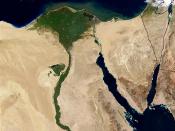Cairo, Egypt
1890
The first canal between the Nile River delta and the Red Sea was excavated about the 13th century BC, possibly at the command of an Egyptian ruler, either Seti I or Ramses II. For long periods of time during the next 1000 years the canal was neglected, but several rulers at various times had it re-excavated or modified. All efforts to uphold it in good condition were abandoned in the 8th century AD. From time to time thereafter various proposals to dig a canal across the Isthmus of Suez were advanced, but no action was taken.
In 1854 the French diplomat and engineer Vicomte Ferdinand Marie de Lesseps succeeded in enlisting the interest of the Egyptian viceroy Said Pasha in the project. In 1858 La Compagnie Universelle du Canal Maritime de Suez (Universal Company of the Maritime Suez Canal) was formed with authority to cut a canal and to operate it for 99 years, after which ownership would return to the Egyptian government.
The company was originally a private concern for Egypt; their stocks were owned mainly by French and Egyptian interests. In 1875 the British government purchased Egypt's shares.
The majority of the people in Britain opposed the idea of a Suez Canal. One of those who thought the canal was a good idea was King William IV, and he wrote to Lord Palmeston in 1833 that it was in Britain's interest, as ruler of India, to become a more friendly ally of Egypt. The reasoning behind this communication is that the king was thinking of the quicker (and shorter) route for passengers, cargoes, and mails traveling between Britain and India. The canal provides a shortcut for ships operating between both European and American ports and ports located in southern Asia, eastern Africa, and Oceania.


